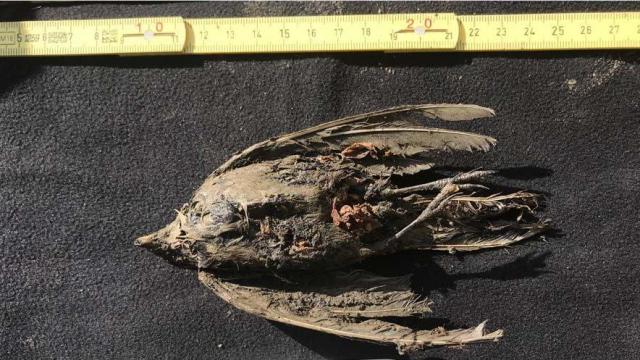On Jacquelyn Gill’s first day doing field work at the Siberian permafrost caves during the summer of 2018, a local fossil hunter approached her with a dead bird in his hands. The translator hadn’t yet arrived, but from the freshly dead look of the bird, Gill assumed it had just recently flown into the cave and died. A modern bird was of little interest to her team, which had flown to this remote region and trekked for miles to study remnants of the last ice age. The man, however, was persistent in offering her the dead bird.
Finally, the translator showed up and revealed what the fossil hunter was trying to tell Gill: The bird was ancient, one of the first frozen bird carcasses ever found in a late Pleistocene permafrost deposit.
“This is an ice age traveller, and I can touch it,” Gill, an assistant professor in climate science at the University of Maine, told Gizmodo.
In the boreal forest 30 kilometres east of the remote town of Belaya Gora in Siberia, north of the Arctic Circle, the international ban on the ivory trade has driven fossil hunters to blast a network of tunnels into the permafrost using firehoses, looking for preserved mammoth tusks and rhino horns. But the legal ancient ivory trade doesn’t just uncover bones; it has revealed a wealth of paleontological treasures from a frigid era, from mammoths to ancient horses to the entire, shaggy head of an extinct wolf. This week, scientists have published a description of the bird—an approximately 46,000-year-old female horned lark, a bird still common across the Northern Hemisphere today—telling the story of a vastly different ecosystem from the one where the fossil hunters dig today.
Prior to Gill’s visit, the fossil hunters, who are legally permitted to dig the tunnels, invited researchers to come see the wealth of finds they’d uncovered. One of the hunters had found the bird 150 meters into a tunnel, around 7 meters underground. Scientists brought the bird back to a lab in the Centre for Palaeogenetics in Stockholm, Sweden, where they carbon-dated the specimen, determining its age based on the ratio of radioactive carbon molecules in its tissue, and sequenced its genome. They, too, were shocked by how well-preserved the sample was.
“We’re talking about a very fragile specimen,” Nicolas Dussex, the study’s first author from the Centre for Palaeogenetics, told Gizmodo. Anything could have crushed the hollow-boned carcass over the millennia, and yet it remained pristine. “We could even look at the contents of its stomach if we had the chance. It’s like entering a walk-in freezer and finding a thing that’s been stored for 45,000 years.”
Knowing the identity of the bird can tell us about the environment of ancient Siberia. Today, horned larks are notable for their love of vast, open habitats—they frequent cleared agricultural fields, beaches, and airports. The bird’s presence falls in line with other finds in the caves, like bison, horses, and mammoths, suggesting that this region was covered by a mixture of tundra and steppe habitats all those years ago, according to the paper published in the journal Nature Communications Biology.
“There’s been an incredible ecosystem change since the last glacial period,” Gill told Gizmodo. The lost habitat goes hand-in-hand with the lost species; as the last ice age came to an end and the large mammals found in the cave died out, the area lost its large grazers, which had provided important ecosystem services that maintained the region. The change of the ecosystem would have contributed to further species extinctions.
But the horned lark survived the region’s transformation. The genetic analysis placed the bird as an ancestor of two surviving horned lark subspecies, one that lives in Scandinavia and Northern Russia and another that inhabits the arid lands of Mongolia, Kazakhstan, and China. Perhaps this bird was a direct ancestor of both. “It doesn’t have to be a rare species to be exciting. The fact that it survived the challenges of climate change commands a lot of respect,” Gill said.
Thinking about the stories of survival through the end of the last ice age can have equal importance to ecologists today. “Comparing the Ice Age horned lark with its great grandbaby larks can tell us something about the through-line and help us get a better handle on who survives and why, and how we can maybe help species out as they go into this accelerated rate of climate change,” Gill said.
The scientists will continue studying this specimen, hoping to learn how horned larks accumulated mutations in their DNA over time, in order to understand evolution more generally. And given the demand for ancient ivory, there will certainly be more finds where this came from. You can learn more about Gill’s visit in the Science Channel documentary “Lost Beasts of the Ice Age” that aired last year.
